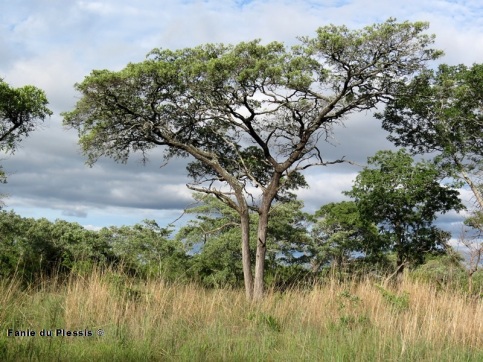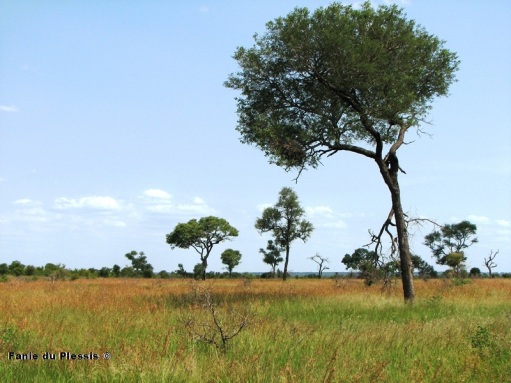To most people, grasses are probably the last thing they look at when visiting the Kruger National Park. So what makes grass special? Different grass species have unique ecological niches and play different roles in plant community succession. Therefore, if you can identify the dominant grass species in an area, you will be able to get a good idea of the recent climatic past, the underlying geology, veld condition, fire history and grazing impact of that area (remember the 4 drivers of savannas?). Grasses are a treasure chest of information! Let’s now look at some examples of different types of grasses.
Pioneer grasses are the first species to inhabit areas with bare soil caused by a recent drought and/or severe overgrazing. Their presence can also indicate unfavourable soil conditions such as bare sodic patches where other grasses struggle to grow. They are normally annuals which focus more on seed dispersal rather than growth. Due to the limited nutrients at their disposal and limited leaf material, they have very low grazing potential. Pioneer grasses are extremely important in stabilizing bare soil and preventing erosion. Their growth also creates better soil conditions for more long-lived species to settle. Examples from Kruger: Carrot-seed grass (Tragus berteronianus); Curly-leaved Dropseed (Sporobolus nitens).
Sub-climax species dominate areas with moderate rainfall but low nutrients and also areas with good nutrient levels but low rainfall. They replace pioneer species when soil conditions become more favourable for plant growth but can still be an indication of past overgrazing if found in areas which possess favourable climatic and/or soil conditions. These grasses normally live for a few seasons and are therefore semi-perennial. They focus on seed production. Therefore their inflorescence (flowering parts) tends to be conspicuous. However, most species are also moderately utilized by grazers and have a fair grazing value. Examples from Kruger: Broad Curly Leaf (Eragrostis rigidior); Herringbone Gras (Pogonarthria squarrosa).
Lastly we have Climax grasses which succeed the sub-climax species. These grasses only grow in areas with favourable soil and/or climatic conditions for perennial species. They focus on growth and maintenance rather than seed dispersal and therefore the leaves are broad and/or the culms (stems) are tall. These grasses can be divided into 3 main ecological groups based on their reaction to grazing and their gazing value.
The first group of Climax grasses increase with low grazing activity. These grasses tend to be dominant in areas with high rainfall and low nutrients, especially in areas with colder winters. Due to the nutrient-poor soils they grow in, as well as the cooler dry season they must cope with, these grasses focus on storing nutrient reserves for the harsh times. They are normally relatively popular with grazers at the start of the rainy season when their leaves and culms are still soft and juicy. However, as the winter nears, the above-ground parts dry out as the grass starts to store all their nutrients in the below-ground parts of the plant to protect it from the cold period ahead. This leads to the term “Sourveld” which is used to describe areas with palatable grazing in summer but unpopular grazing in winter. Examples from Kruger: Yellow Thatching-Grass (Hyperthelia dissoluta); Common Thatching-Grass (Hyparrhenia hirta ).

Tall sourveld, dominated by Hyperthelia dissoluta, near Pretoriuskop, KNP
The next group of Climax grasses increase with overgrazing through the weakening of more palatable species. They are normally more prevalent in areas with high rainfall. If a game farm owner finds this group of grasses dominating his land, he has a serious problem. They normally have very low grazing value and because they are climax grasses, they prevent any tastier species from gaining a foothold on the property. The only way to get rid of these grasses is to keep the area basically free from any grazing activity for a couple of seasons. These grasses tend to weaken if new growth is not stimulated by grazing and due to a buildup of moribund plant material. To the farmer these grasses are a pest but in reality it is actually a clever way of nature to protect an overgrazed area from further degradation by “chasing away” grazers so the area can recover. Example from Kruger: Wire Grass (Elionurus muticus).
The last group of Climax grasses decreases with overgrazing and dominate in areas with optimal veld conditions such as nutrient-rich soils, sufficient rainfall and moderate grazing impact. These grasses produce a lot of juicy, nitrogen-rich plant material which is highly sought after by grazers. Due to optimal growth conditions, these grasses tend to focus more on growth than on storage. For this reason they are very sensitive to over-grazing and quickly start to weaken when conditions become less favourable. The term “Sweetveld” is used for areas dominated by these species, as they stay palatable through the dry season, not having to retract their nutrients below ground. Examples from Kruger: Guinea Grass (Panicum maximum); Red Grass (Themeda triandra).

Sweetveld dominated by Themeda triandra, between Orpen and Satara, KNP
An area with a mix of sweetveld and sourveld components is called Mixed veld. This veld type is often found in areas with moderate rainfall and pronounced catenas (see Kruger Ecology 3: Broad-leaved and Fine-leaved). The sweetveld component is then associated with the nutrient-rich, fine-leaved valleys while the sourveld is found on the nutrient-poor, broad-leaved hills.
The sensitivity of decreaser palatable grass species to overgrazing can be seen as one of several significant motivators for expanding protected natural areas through initiatives such as Transfrontier Parks and Regional Conservancies. Before humans introduced fences, many grazers moved far and wide on seasonal migration routes determined by grazing- and water availability. Palatable climax grasses were therefore adapted to moderate grazing for short periods every year as the grazers moved through their area. When the animals moved away, these grasses had time to recover again. Of course this is no longer the case in most small fenced-in farms and reserves, putting strain on palatable grasses everywhere. It takes a lot of effort and intense management and monitoring to keep the veld in a good condition on smallish properties. The effect is the severe over-grazing and veld deterioration that can be seen all over the bushveld of South Africa. Larger unfenced ecosystems provide more space for natural migratory patterns to operate and ultimately improve the overall veld condition of the protected area.
References: